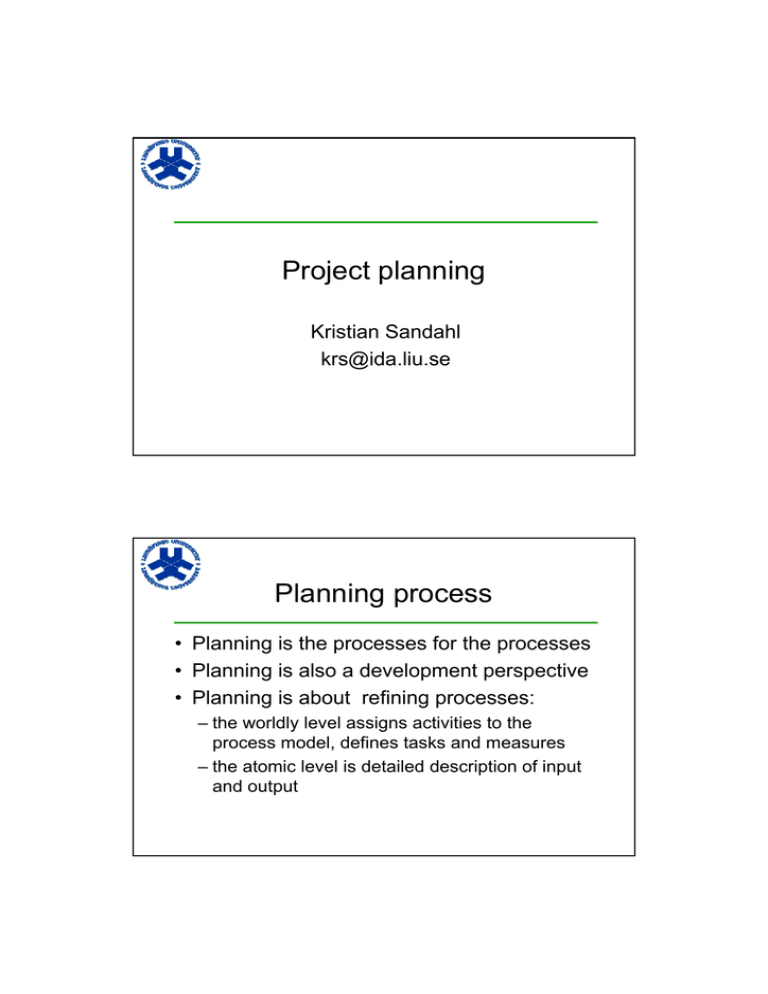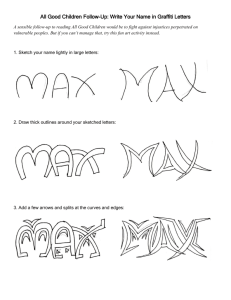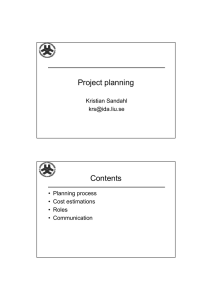Project planning Planning process
advertisement

Project planning Kristian Sandahl krs@ida.liu.se Planning process • Planning is the processes for the processes • Planning is also a development perspective • Planning is about refining processes: – the worldly level assigns activities to the process model, defines tasks and measures – the atomic level is detailed description of input and output What is a project? • A temporal organisation with specific goals: – Functions – Quality – Time – Resources The project plan • Shall always be written down. • Shall be readable to all stakeholders of the project. • We’ll go through some important parts of a project plan with theory and recommendations. Administrative information • • • • • • • Project identity Members: name, role, phone, email Version number Mailing lists Home pages Customer contact Table of contents Overview • Purpose • Prioritised goal(s), sub goals, internal goals • Limitations and constraints: – – – – – Hardware Resources Time Technology Knowledge • Stake-holders: primary, secondary, indirect Phase plan prestudy feasability study System development phases inception elaboration transition construction conculsion the Topic for n project pla Project managment phases execution Same management, different development prestudy feasability study System development phases analysis conculsion design testing implementation execution Project managment phases Organisation • • • • • • • Place of the project Teams Roles Responsibilities Authorities Communications Documents • Recommended roles: – – – – – Project leader Lead analyst Architect Test leader Librarian/Knowledge manager • Testers should be independent Project manager • • • • • • • • • Has the final word on all matters Manages resources Ensures goals Makes staffing Plans Reports internally, externally Leadership Social skills High technical skill Lead analyst • • • • • • • • • • Defines services provided Captures requirements Models the forthcoming system Handles contacts with customer and users Has the final word on requirements interpretations Assists marketing Writes requirements specification Very good communication skills High analytical skills Good domain and business knowledge Architect • Has the final word in technical matters • Decide and specifies: – – – – • • • • target environment high-level architecture sourced components external interfaces Ensures requirements Highest possible technical skills Leadership Social skills Test leader • • • • • • • • • Evaluates requirements Creates and selects test cases Creates and maintains a test environment Feed-back test results Decides the status of the product Very high analytical skills Very high technical skills Skills in statistics Sometimes the default deputy PL Librarian/Knowledge manager • • • • • • • • Keeps documents in good order Makes documents available Follow-up on administrative decisions’ Collects time-reports Identifies reusable components Creates common experience Very high sense for good order Experience as developer Other useful roles • • • • • • • Development manager Procurement manager Economic controller Quality coordinator Deployment responsible Technical writer Course developer Documentation plan Internal: • Minutes of meetings • Meeting agendas • Time reports • Experience build-up • Inspection records • Accounting • Group contract • Mile-stone review External: • Requirements specification • Design specification • Test report • Manuals • Economic communication • Promotion material • Toll-gate preparation Training and education • Internal: – – – – • External: Tools Techniques Methods Maturity – Customers – Users – Operation Resource plan • People: – Expertise – Availability • • • • • • • Premises Hardware Software Testing equipment Travelling Customer time Budget Meeting plan • • • • Type of meeting Frequency Process Participation Communication genres Mile-stone and tollgate plan Toll-gate Decision about the continuation of the project by external committee Mile-stone Verifying sub-goal fulfilment. Can be done internally. Plan and follow-up follow-up periods outcome initial plan time Activities • • • • • Number Name Resources Duration Break down per person no 1 2 3 4 ... descr interv UML spec val ... who A,K K,U K M,K ... w1 50 5 0 0 ... w2 20 50 0 0 ... w3 5 50 50 0 ... w4 0 25 50 75 ... Gantt chart I Tas ' 0D3u 1 För I n le d a 24 d5 3 In s a m 10 4 S y s te 5 K ra vs 2 6 P ro j 2 7 B 8 R edov. 1 9 I n lä m n . 0 2 1 H uv d 1 D 1 2 28 d5 1 B 1 S y s te m m 1 1 I n lä m n i 0 1 Ko 1 S y s te m m 1 T e s tf 5 1 Te 5 1 B 2 2 I n lä m n i 0 2 In te 2 S y s te m 1 2 B 3 2 S y s t e m m ö t e -1 2 R ed 2 P r o je k 2 t St a ä m m anst 2 B 2 I n lä m n in g 3 I n s a m lin 5 10 1 5 1 10 d7 3 0 50 3 H a lv t i 1 3 U tv 1 '0 3 '0 3 '0 3 '0 3 '0 3 '0 3 '0 3 '0 3 '0 3 '0 3 '0 3 '0 3 '0 3 2 2 2 2 2 0 0 0 0 0 1 1 1 1 1 2 2 2 2 2 3 0 0 0 0 1 1 1 1 1 2 2 2 2 2 3 0 0 0 0 1 1 1 1 1 2 time(h) 75 130 100 75 ... Quality and Change Quality plan: • Tests: – – – – • • • • • Change plan: • Request • Process • Decision • Documentation • Configuration management • Follow-up unit test system test integration test acceptance test Inspections Reviews Measurements Follow-up Experience feed-forward Risk analysis risk PL ill delay probability 3 1 risk PL ill delay risk 6 4 severity 2 4 remedy cost 2 4 risk 6 4 threat 12 16 Introduction of project plan • • • • • • Project overview Main deliverables Main milestones Library for documents and code Definitions Communication with stake-holders Project management process • • • • • • Staffing Priorities Philosophy Risk management Task refinement Routines for reporting COCOMO • Effort = C1 EAF (Size)P1 – Effort = number of staff months – C1 = scaling constant – EAF = Effort Adjustment Factor – Size = number of delivered, human produced source code instructions (KDSI) – P1 = exponent describing the scaling inherent of the process COCOMO • Time = C2 (Effort)P2 – Time = total number of months – C2 = scaling constant – P2 = Inherent inertia and parallelism in management DELPHI • • • • • Present information for expert panel Meet to discuss a common view Independent, personal estimates Summary Discussion and second round Experience Factory • Infrastructure for logging measurements and software item components • Goal: reuse • Example of output: trends, similar project data, validation of hypotheses • Has been around since 1976 at NASA • Consumes about 10% of the budget

